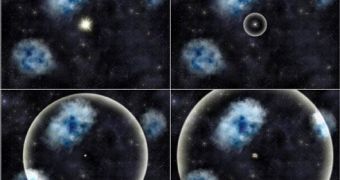With the help of light echoes, astronomers have been recently able to measure the brightness of a supernova explosion which took place about 400 years ago. The so-called SNR 0509-67.5 supernova remnant is located in the Large Magellanic Cloud, a galaxy in the near vicinity of our own Milky Way. While the original light of the explosion would have been observed from the surface of the Earth 400 years ago, part of the light traveled towards clouds inside the Large Magellanic Cloud and reflected back towards Earth.
Because the light did not travel in a straight direction towards Earth, it actually spent more time while traveling through space allowing us to view it 400 years later. "People didn't have advanced telescopes to study supernovae when they went off hundreds of years ago. But we've done the next best thing by looking around the site of the explosion and constructing an action replay of it," said Harvard University researcher Armin Rest.
During observations the researching team used the Cerro-Tololo Inter-American Observatory and the Gemini South telescope. Additionally the Chandra X-ray Observatory and the XMM-Newton Space Telescope were used to conduct observations in the X-ray wavelengths of the electromagnetic spectrum. The comparison of the two sets of observations gave astronomers the opportunity to estimate the power and the brightness of the explosion at the time when it occurred.
It now seems that the SNR 0509-67.5 was a Type Ia supernova explosion experiencing a powerful emission of energy, which means that it could have been caused only by a white dwarf that accumulated too much matter from the surrounding area, thus becoming unstable. At some point in time, the instability became too great and energy had to be released through an explosion. The power experienced by the SNR 0509-67.5 supernova explosion is approximated to about that of a recent supernova explosion known as SN 1991T.
It is believed that it could have exploded roughly in the same period of time as the famous Kepler supernova, discovered in 1604 by Johannes Kepler. Event though the two events took place in different areas of the sky, Kepler's supernova was also a subject of discussion for astronomers. Allegedly, the original explosion of SNR 0509-67.5, which produced the light echo nearly 4 centuries ago was not observed or historically recorded on Earth.
Light echoes are routinely used in the study of ancient supernovae explosion to evaluate the energy released during the explosion event.

 14 DAY TRIAL //
14 DAY TRIAL //